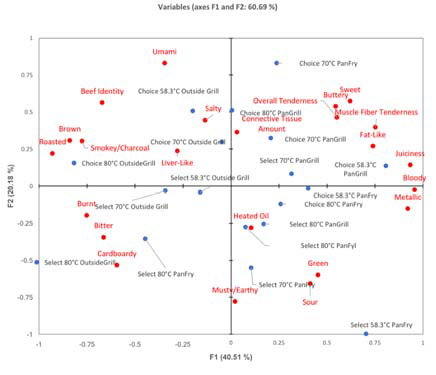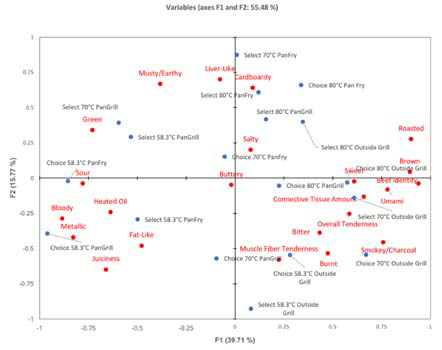Project Summary
Flavor Myology
- Principle Investigator(s):
- Rhonda K. Miller1, Hannah L. Laird1, Chris R. Kerth1, Dale Woerner2 and Devin Gredell2
- Institution(s):
- 1Texas A&M University
- 2Colorado State University
- Completion Date:
- July 2017
Background
It has been well established that cooking method, marbling level and cooked internal temperature endpoint affect beef flavor and beef flavor has been shown to be the most important driver of consumer acceptance. But beef cuts respond differently to cooking method and cooked internal temperature endpoint based on their inherent chemical characteristics. Beef cuts differ in chemical characteristics based on muscle function in the live animal. Extensive work was conducted through the Beef Checkoff to understand chemical and tenderness characteristics of beef cuts and is available as the Beef Myology website. This website is used by university, industry and government entities to understand inherent characteristics of individual beef cuts and how to maximize their value as a protein source. However, an understanding of how to maximize flavor of individual cuts, the influence of cooking method, marbling level and cooked internal temperature endpoint across beef cuts has not been fully characterized. Recent Beef Checkoff‐funded research has examined the relationship between different cooking methods, degree of doneness, cuts, and marbling scores on consumer, trained sensory descriptive sensory flavor, and aromatic volatile chemicals. These data sets provide a base for understanding the effect of cooking method, marbling level and internal cook temperature endpoint on beef flavor across cuts. There is a need to centralize information in a user-friendly manner for each beef cut, how flavor is impacted by cooking method, how marbling level impacts flavor, and how internal cooked temperature endpoint affects beef flavor. However, there is a need to expand the information to include new cuts and new cooking methods. This project incorporated existing data and generated new data to be used in the development of a Beef Flavor Myology tool.
The project objectives were to develop a research, education and consumer resource that establishes flavor of major beef cuts as affected by cooking method and internal cooking endpoint.
Methodology
USDA upper two thirds Choice and USDA Select beef plate, inside skirt, beef plate, outside skirt, skinned and beef loin, bottom sirloin butt, flap boneless subprimals were purchased. The inside and outside skirts were cut in 10.16 cm portions and one portion was randomly assigned to cooking and degree of doneness treatments for trained panel sensory evaluation. The flap steaks were cut in half and one half was randomly assigned to trained panel sensory evaluation. The steaks were vacuum‐packaged, aged for 14 d, frozen and stored at ‐40° C until evaluated.
The steaks were cooked using a pan fry, pan grill, or outside grill methods. The steaks were cooked to an internal temperature of either 58.3, 70 or 80°C to represent medium rare, medium and well done steaks. The steaks were evaluated by an expert trained meat descriptive attribute panel using the Beef Flavor Lexicon (Adhikari, 2011). Volatile aromatic compounds were captured from the same steaks evaluated by the trained panelists at Texas A&M University and Colorado State University. Volatiles were evaluated using the Aroma Trax gas chromatograph/mass spectrophotometer system with dual sniff ports for characterization of aromatics.
Findings
Choice top loin steaks should be cooked to a lower degree of doneness on grills to avoid liver‐like flavors and to maximize positive beef flavor attributes. Top loin steaks cooked either using George Foreman grills, ovens or crock pots had higher levels of negative flavor attributes. These data can be used to develop a Beef Flavor Myology tool for consumers and foodservice individuals.
For Phase II, cooking method and internal cook temperature endpoint tended to impact beef flavor to a greater extent than USDA Beef Quality grade for outside skirt, inside skirt and flap steaks. Pan frying tended to result in more off‐flavor development and outside grilling was more often associated with positive flavor attributes. Choice steaks tended to have more positive beef flavor attributes such as beef identity, umami, brown and roasted. Pan grilling tended to result in intermediate flavor for steaks when compared to steaks cooked using outside grilling and pan-frying cooking methods.
Implications
Beef flavor has been identified as a key component of beef demand. However, beef flavor is very complex and is markedly impacted by marbling level, cooking method and cooked internal temperature endpoint. The beef industry has recognized beef flavor as an important aspect of consumer acceptability and has conducted research to address factors impacting beef flavor through the Beef Checkoff program. This research will use past research to begin the development of a Beef Flavor Myology tool. This tool will be designed to assist beef industry personnel, either foodservice or retail segments, in determining appropriate factors that impact beef flavor across beef cuts, marbling levels, cooking methods and cooked internal temperature endpoints. However, not all information on factors that impact beef flavor across cuts, marbling levels, cooking methods and cooked internal temperature endpoints are known. The second phase of this project will conduct research to fill in the gaps of this knowledge.

Figure 1. Flap principal component analysis for descriptive sensory flavor attributes and the treatments.

Figure 2. Inside skirt principal component analysis for descriptive sensory flavor attributes and the treatments.

Figure 3. Outside skirt principal component analysis for descriptive sensory flavor attributes and the treatments.
References
- Adhikari, Koushik, et al. 2011. Development of a lexicon for beef flavor in intact muscle. Journal of Sensory studies. 26.6:413‐420.